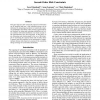Free Online Productivity Tools
i2Speak
i2Symbol
i2OCR
iTex2Img
iWeb2Print
iWeb2Shot
i2Type
iPdf2Split
iPdf2Merge
i2Bopomofo
i2Arabic
i2Style
i2Image
i2PDF
iLatex2Rtf
Sci2ools
FLAIRS
2008
2008
Second-Order Risk Constraints
This paper discusses how numerically imprecise information can be modelled and how a risk evaluation process can be elaborated by integrating procedures for numerically imprecise probabilities and utilities. More recently, representations and methods for stating and analysing probabilities and values (utilities) with belief distributions over them (second order representations) have been suggested. In this paper, we are discussing some shortcomings in the use of the principle of maximising the expected utility and of utility theory
Artificial Intelligence | FLAIRS 2008 | Imprecise Probabilities | Risk Evaluation Process | Second Order Representations |
Related Content
| Added | 02 Oct 2010 |
| Updated | 02 Oct 2010 |
| Type | Conference |
| Year | 2008 |
| Where | FLAIRS |
| Authors | Love Ekenberg, Aron Larsson, Mats Danielson |
Comments (0)

